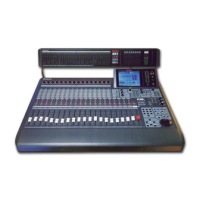
Do you have a question about the Panasonic WR-DA7 and is the answer not in the manual?
| Brand | Panasonic |
|---|---|
| Model | WR-DA7 |
| Category | Music Mixer |
| Language | English |
Detailed explanation and illustration of the mixer's top control surface.
Details the LCD screen, meter displays, and status indicators.
Explanation of all input/output connectors, switches, and option slots.
Basic procedure for connecting sources and achieving audio output.
Overview of EQ, Dynamics, and Delay features available on channels.
Explains how to route signals for external processing using aux sends and inserts.
Describes different ways to listen to sources via monitor outputs.
Essential operational tips, shortcuts, and critical warnings for safe use.
Functionality for canceling or reapplying recent operations.
Details elements and controls for selected channels.
Information on storing and recalling Channel, EQ, and Dynamics settings.
Explains windows accessed via the METER button.
Details multi-channel view of channel window.
Selects current function for channel strips and updates fader positions.
Describes tools for assigning and controlling channel parameters.
Accessing and activating top panel EQ controls.
Details functionality and areas within the EQ window.
Covers functions for storing and recalling EQ presets.
Access to pan, surround, and bus assignment controls.
Setting parameters for surround sound mixing.
Details multi-channel view for surround settings.
Explains top panel controls for editing parameters.
Details controls for adjusting dynamics and delay attributes.
Describes multi-channel view of dynamics window.
Details controls for AUX sends, pre/post, and fader control.
Displays aux send status and allows pre/post and on/off selections.
Configuration settings for MIDI operations and computer connection.
Sets sample rate, wordclock source, and routes digital inputs.
Assigns direct output to option cards and functions as a patch bay.
Selects channels for fader group control.
Registers channels to groups for controlled mute operations.
Designates adjacent channel pairs for fader linking or stereo operation.
Sets up automation and stores/recalls library events.
Principally controls automation recording and playback.
Changes automation parameters off-line.
Preparations and procedures for starting automation.
Records and recalls global mixer setups (scenes).
Controls monitoring functions, talkback, and solo operations.
Defines mixer configuration and user personality settings.
Overview of MIDI functions and parameters.
Table mapping control changes to mixer parameters.
Table mapping program changes to scene memories.